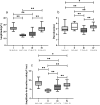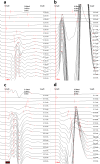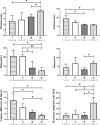Effect of Sympathetic Blockade on Spontaneous Discharge and the H-Reflex at Myofascial Trigger Points in Rats
- PMID: 38563034
- PMCID: PMC10982455
- DOI: 10.2147/JPR.S449750
Effect of Sympathetic Blockade on Spontaneous Discharge and the H-Reflex at Myofascial Trigger Points in Rats
Abstract
Purpose: Myofascial trigger points (MTrPs) are the main cause of myofascial pain syndrome (MPS), and patients with MPS also have symptoms of sympathetic abnormalities. Consequently, this study aimed to investigate the potential relationship between MTrPs and sympathetic nerves.
Materials and methods: Twenty-four seven-week-old male rats were randomly divided into four groups (six rats every group). Groups I and II were kept in normal condition (n=12), and groups III and IV underwent MTrPs modelling (n=12). After successful MTrPs modelling, differences in sympathetic outcomes between the MTrPs groups (III and IV) and non-MTrPs groups (I and II) were observed. Sympathetic blockade was then applied to groups III and I (n=12). Data were collected on peak inversion spontaneous potentials (PISPs) and the H-reflex-evoked electromyography during spontaneous discharge at the MTrPs before and after sympathetic blockade.
Results: Systolic blood pressure, diastolic blood pressure, mean arterial pressure, and heart rate were significantly higher in the MTrPs group than in the non-MTrPs group (P<0.05). Compared with group I, group III had the PISPs potential lower wave amplitude, shorter duration and amplitude-to-duration ratio, and lower H latency and latency difference H-M (P<0.05). Compared with group IV, group III had the PISPs potential lower wave amplitude, duration, amplitude-to-duration ratio, M-wave latency, H maximum wave amplitude, and maximal wave amplitude ratio H/M (P<0.05). The changes before and after sympathetic blockade in the MTrPs group were significant, and the amplitude, duration, and amplitude-to-duration ratio of the PISPs potentials were lower after the blockade (P<0.05).
Conclusion: MTrPs and sympathetic nerves interact with each other forming a specific relationship. MTrPs sensitize sympathetic nerves, and sympathetic nerve abnormalities affect local muscle myoelectric hyperactivity, leading to MTrPs. This finding is instructive for the clinical management of sympathetic disorders.
Keywords: H-reflex; electromyography; myofascial pain syndrome; myofascial trigger point; sympathetic blockade.
© 2024 Liu et al.
Conflict of interest statement
The authors reports no conflicts of interest in this work.
Figures







Similar articles
-
Sympathetic hyperinnervation in myofascial trigger points.Med Hypotheses. 2020 Jun;139:109633. doi: 10.1016/j.mehy.2020.109633. Epub 2020 Feb 14. Med Hypotheses. 2020. PMID: 32087493
-
The key role of muscle spindles in the pathogenesis of myofascial trigger points according to ramp-and-hold stretch and drug intervention in a rat model.Front Physiol. 2024 May 14;15:1353407. doi: 10.3389/fphys.2024.1353407. eCollection 2024. Front Physiol. 2024. PMID: 38808356 Free PMC article.
-
Assessment of the effects of transforming growth factor beta1 (TGF-β1)-Smad2/3 on fibrosis in rat myofascial trigger points using point shear wave elastography.PeerJ. 2023 Dec 6;11:e16588. doi: 10.7717/peerj.16588. eCollection 2023. PeerJ. 2023. PMID: 38077437 Free PMC article.
-
Prevalence of myofascial trigger points in fibromyalgia: the overlap of two common problems.Curr Pain Headache Rep. 2010 Oct;14(5):339-45. doi: 10.1007/s11916-010-0127-5. Curr Pain Headache Rep. 2010. PMID: 20607459 Review.
-
The prevalence of myofascial trigger points in neck and shoulder-related disorders: a systematic review of the literature.BMC Musculoskelet Disord. 2018 Jul 25;19(1):252. doi: 10.1186/s12891-018-2157-9. BMC Musculoskelet Disord. 2018. PMID: 30045708 Free PMC article.
References
-
- Doroshenko M, Turkot O, Horn DB. Sympathetic nerve block. In: StatPearls. StatPearls Publishing; 2023. Available from: http://www.ncbi.nlm.nih.gov/books/NBK557637/. Accessed November 7, 2023. - PubMed
LinkOut - more resources
Full Text Sources

